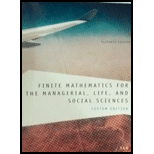
In Exercises 9-18, determine whether the two-person, zero-sum matrix game is strictly determined. If a game is strictly determined,
a. Find the saddle point(s) of the game.
b. Find the optimal strategy for each player.
c. Find the value of the game.
d. Determine whether the game favors one player over the other.
Want to see the full answer?
Check out a sample textbook solution
Chapter 9 Solutions
Finite Mathematics for the Managerial, Life, and Social Sciences-Custom Edition
- 2. In each case below, state whether the statement is true or false. Justify your answer in each case. (i) Suppose A and B are sets. Then, AnB = 6 ⇒ AUB = A (ii) Suppose A and B are sets. Then, AUB = B ⇒ ACB (iii) Suppose A and B are sets. Then, AUB = B ⇒ B C Aarrow_forward5arrow_forwardNo chatgpt pls will upvotearrow_forward
- not use ai pleasearrow_forwardPidgeonhole Principle 1. The floor of x, written [x], also called the integral part, integer part, or greatest integer, is defined as the greatest integer less than or equal to x. Similarly the ceiling of x, written [x], is the smallest integer greater than or equal to x. Try figuring out the answers to the following: (a) [2.1] (b) [2] (c) [2.9] (d) [2.1] (e) [2] (f) [2.9] 2. The simple pidgeonhole principle states that, if you have N places and k items (k> N), then at least one hole must have more than one item in it. We tried this with chairs and students: Assume you have N = 12 chairs and k = 18 students. Then at least one chair must have more than one student on it. 3. The general pidgeonhole principle states that, if you have N places and k items, then at least one hole must have [] items or more in it. Try this out with (a) n = 10 chairs and k = 15 students (b) n = 10 chairs and k = 23 students (c) n = 10 chairs and k = 20 students 4. There are 34 problems on these pages, and we…arrow_forwardDetermine if the set of vectors is linearly independent or linearly dependent. linearly independent O linearly dependent Save Answer Q2.2 1 Point Determine if the set of vectors spans R³. they span R³ they do not span R³ Save Answer 23 Q2.3 1 Point Determine if the set of vectors is linearly independent or linearly dependent. linearly independent O linearly dependent Save Answer 1111 1110 Q2.4 1 Point Determine if the set of vectors spans R4. O they span R4 they do not span IR4 1000; 111O'arrow_forward
- The everything combined problem Suppose that a computer science laboratory has 15 workstations and 10 servers. A cable can be used to directly connect a workstation to a server. For each server, only one direct connection to that server can be active at any time. 1. How many cables would you need to connect each station to each server? 2. How many stations can be used at one time? 3. How many stations can not be used at any one time? 4. How many ways are there to pick 10 stations out of 15? 5. (This one is tricky) We want to guarantee that at any time any set of 10 or fewer workstations can simultaneously access different servers via direct connections. What is the minimum number of direct connections needed to achieve this goal?arrow_forwardCan you help me with D and Earrow_forwardQ1.1 1 Point Any set {V1, V2, V3, V4} that consists of four different vectors from R cannot possibly span Rº. True False Save Answerarrow_forward
- 4. Let A {w, e, s, t, f, i, e, l, d, s, t, a, t, e}. (a) How many different words (they do not have to make sense) can you spell with the letters in A? (b) Is your answer from above the same as the cardinality of the powerset of A, i.e. of P(A)? (c) What is |A|?arrow_forward5. How many numbers can you make out of the digits 1, 2, 3, 4, 6 if the rule is that every digit has to be larger than the digit preceding it? For example 124 is ok, 122 is not ok. Every digit can be used only once, but you do not have to use every digit. A tree might help.arrow_forwardCan you help me with f and g?What they are asking is, what do you shade in? Not the power set. At least for Farrow_forward
 Advanced Engineering MathematicsAdvanced MathISBN:9780470458365Author:Erwin KreyszigPublisher:Wiley, John & Sons, Incorporated
Advanced Engineering MathematicsAdvanced MathISBN:9780470458365Author:Erwin KreyszigPublisher:Wiley, John & Sons, Incorporated Numerical Methods for EngineersAdvanced MathISBN:9780073397924Author:Steven C. Chapra Dr., Raymond P. CanalePublisher:McGraw-Hill Education
Numerical Methods for EngineersAdvanced MathISBN:9780073397924Author:Steven C. Chapra Dr., Raymond P. CanalePublisher:McGraw-Hill Education Introductory Mathematics for Engineering Applicat...Advanced MathISBN:9781118141809Author:Nathan KlingbeilPublisher:WILEY
Introductory Mathematics for Engineering Applicat...Advanced MathISBN:9781118141809Author:Nathan KlingbeilPublisher:WILEY Mathematics For Machine TechnologyAdvanced MathISBN:9781337798310Author:Peterson, John.Publisher:Cengage Learning,
Mathematics For Machine TechnologyAdvanced MathISBN:9781337798310Author:Peterson, John.Publisher:Cengage Learning,






